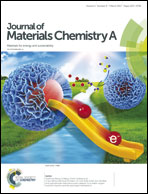Flexible thermally treated 3D PIM-CD molecular sieve membranes exceeding the upper bound line for propylene/propane separation
Abstract
Polymers of intrinsic microporosity (PIM) incorporated with beta-cyclodextrin (β-CD) (referred to as PIM-CD) are prepared via nucleophilic substitution copolymerization and then thermally treated at elevated temperatures from 300 to 600 °C. After the decomposition of thermally labile CD, the spaces originally occupied by CD convert to micro-pores and cross-linking points in the polymer matrix. The thermally induced three-dimensional (3D) cross-linking network not only possesses ultra-fine micro-pores and interconnected microvoids but also shows a superior molecular sieve ability for propylene/propane separation. The C3H6/C3H8 selectivity of the thermally treated membranes increases remarkably, about 3 times compared to that of the original untreated membranes. In particular, the PIM-CD membranes thermally treated at 300 or 400 °C are flexible, and they have C3H6/C3H8 separation performance exceeding the upper bound line in both pure and mixed gas tests. As observed from the gas sorption isotherms, membranes with a higher content of CD units have a higher gas sorption capacity. Additionally, the diffusivity selectivity of PIM-CD membranes after thermal treatment increases more quickly than that of the PIM membrane and contributes more to the permeability selectivity.



 Please wait while we load your content...
Please wait while we load your content...